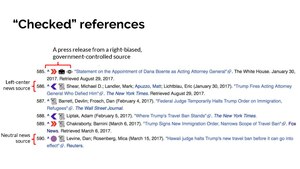Cite Unseen
 Presentation introducing Cite Unseen as delivered at CredCon Austin 2018 | |
| Description | User script that adds iconic indicators to Wikipedia citations |
|---|---|
| Authors | SuperHamster, Sky Harbor |
| Updated | 2023-10-07 (276 days ago) |
| Version | In Beta |
| Script location | en:User:SuperHamster/CiteUnseen.js |
| Version control | https://github.com/KevinPayravi/Cite-Unseen |
| Phabricator | [1] |
| Skin support | Vector |
| Browser support | N/A |
Cite Unseen is a Wikipedia user script that helps readers quickly evaluate the sources used in a given English Wikipedia article. The script adds iconic indicators to identified sources that indicate various attributes of the source, such as if the source is a news article, opinion piece, or government-controlled. This allows readers to quickly and easily identify the potential orientation and possible ideological biases of the sources used in an article they are reading.
Initially developed at CredCon in November 2018, Cite Unseen is jointly developed by Kevin Payravi (SuperHamster) and Josh Lim (Sky Harbor), with support from the Credibility Coalition and the Knowledge Graph Working Group. The project saw more development at Wikimedia Hackathon 2019 and again at the Media Party hackathon in Buenos Aires where a prototype Arabic version was created.
Contributing
[edit]- GitHub Repository
- categorized-domains.json (for categorized domains)
- categorized-strings.json (for categorized non-domain strings)
- Phabricator Board
Anyone is welcome and encouraged to contribute to either the code or JSON categorizations.
